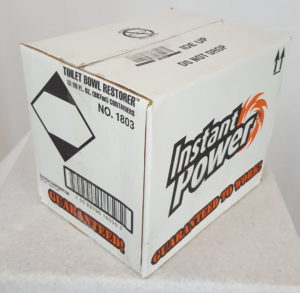Most shipments of hazardous materials subject to PHMSA/USDOT regulations require the use of a specification packaging. There are two types of specification packaging recognized by the Hazardous Materials Regulations (HMR):
- UN Standard (aka: performance oriented packaging). Used for all non-bulk packagings and intermediate bulk containers (IBCs).
- DOT specification. Used for aerosols, cargo tanks, tank cars (rail), portable tanks, and more.
Due to its strict standards of construction, specification packaging can be very expensive. Whenever a shipper has an opportunity to use non-specification packaging – due to an exception to full regulation such as the limited quantity exception – it can result in a significant cost savings.
| Note: PHMSA/USDOT is the Pipeline and Hazardous Materials Safety Administration within the U.S. Department of Transportation. What is the PHMSA? |
While most of the exceptions found in the HMR allow for the use of non-specification packaging, only some of them require a “strong outer packaging” to be used in its place. The purpose of this article is to explain what the HMR means by a “strong outer packaging”.
Helpfully, the HMR defines the term at 49 CFR 171.8:
Strong outer packaging means the outermost enclosure that provides protection against the unintentional release of its contents. It is a packaging that is sturdy, durable, and constructed so that it will retain its contents under normal conditions of transportation. In addition, a strong outer packaging must meet the general packaging requirements of subpart B of part 173 of this subchapter but need not comply with the specification packaging requirements in part 178 of the subchapter. For transport by aircraft, a strong outer packaging is subject to §173.27 of this subchapter. The terms “strong outside container” and “strong outside packaging” are synonymous with “strong outer packaging.”
Let’s take a closer look at the definition:
- “…the outermost enclosure…” This may mean it is the outer packaging with one or more inner receptacles (aka: a combination packaging) or it may be the only enclosure (aka: a single packaging). To the best of my knowledge in every instance where the HMR requires a strong outer packaging it is used as part of a combination packaging.
- “…it provides protection against the unintentional release of its contents.” i.e. the HazMat.
- It is “sturdy, durable, and constructed so that it will retain its contents under normal conditions of transportation.” These conditions will vary depending on the mode of transportation (highway, rail, air, vessel), the temperature and season, the origin point and destination and other factors. It is the responsibility of the shipper to consider these variables when selecting the strong outer packaging.
- It must meet the general packaging requirements of 49 CFR 173, subpart B of the HMR. An important section of subpart B applicable to all packagings is §173.24 – General requirements for packagings and packages.
- It does not need to meet the packaging specification requirements of §178 of the HMR (i.e. it does not have to be a specification packaging).
- If to be transported by aircraft it must meet the general packing requirements specific to that mode at §173.27 of the HMR.
- Strong outside container = strong outside packaging = strong outer packaging.
Like this article? Subscribe to my Monthly Newsletter No marketing emails! |
You may wish for more guidance but that is all you are going to get from PHMSA/USDOT. It is up to you as the shipper of a hazardous material to determine if your packaging meets the definition of a strong outer packaging and the other requirements of the HMR applicable to its transportation in commerce. As a shipper of HazMat you are also responsible to provide initial (within 90 days) and recurrent (every three years) HazMat Employee training for any personnel involved in the transportation of a hazardous material.
Contact me with any questions you may have about the transportation of hazardous materials by air, highway, vessel, or rail International and Domestic Daniels Training Services, Inc. 815.821.1550 |
Read more (links to articles below will be provided as they become available):
- What does ICAO/IATA consider to be a ‘good quality packaging’?
- What does ICAO/IATA consider to be a ‘strong outer packaging’ and/or ‘strong rigid outer packaging’?
- What does IMO consider to be a ‘strong outer packaging’?
- What does UPS consider to be a ‘strong outer packaging’ (aka: ‘non-specification packaging’)?
